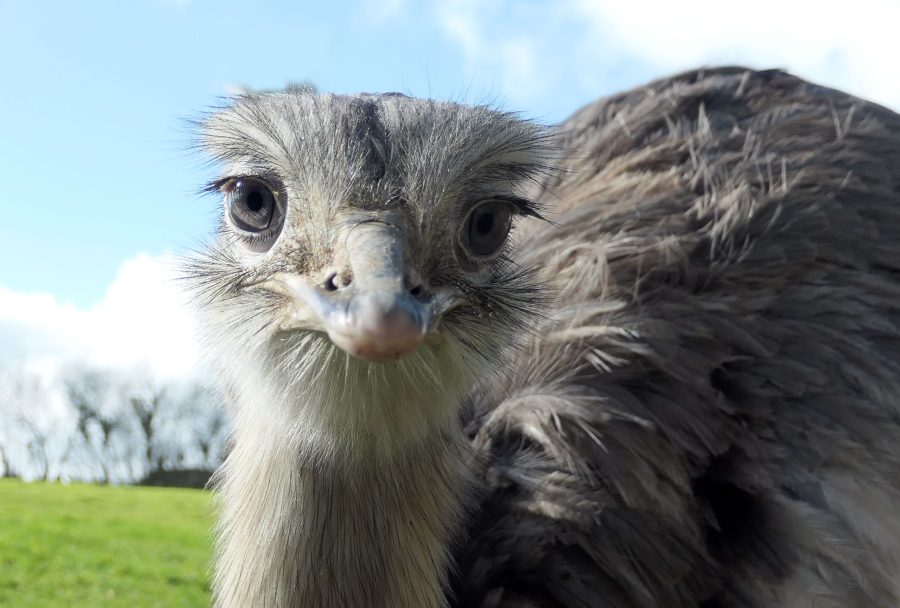The Country Smallholder meets Helen Goldman who, thanks to unwanted fox activity, swapped poultry for emu and has never looked back…
Emus are not an obvious smallholding choice but when Helen Goldman’s poultry suffered repeated fox raids, it became obvious that keeping free range chickens and geese on her land was no longer an option.
Wanting to stick with birds and having read a fair bit about emus, her interest was stirred and one day she found herself at a poultry auction bidding for a single emu chick. £170 later (it had become a bit of a bidding war), her kitchen became an indoor run and her large garden an emu playground. Of course, emus (in keeping with most stock) need to live with their own kind and so within a short time, Scooby was joined by Bruce and Sheila and thus Helen’s emu journey began.
A journey that has since led to her becoming a UK authority on emus via a fantastically authoritative website, two popular Facebook groups and a book in the making. She was also involved in the creation of the emu scene in episode six of the recent Life On Our Planet series, produced by Steven Spielberg and narrated by Morgan Freeman.
Helen knows many UK owners and converses with emu breeders across the world, all in aid of both passing on her now extensive knowledge but also continuing her own research (and love-affair) with these remarkable animals.
INTRODUCING THE RATITE FAMILY
Helen is also involved in emu rescue – sadly, something which is on the rise and as such this article, rather than focusing explicitly on Helen’s ‘change of direction’ is dedicated to exploring the world of emus, and also rhea (we have seven here on our smallholding), and hopefully encouraging both responsible ownership and breeding.
Emus and rhea (and ostriches) all belong to the ratite family along with the cassowary and the kiwi. Ratites are large, flightless birds, the ostrich being the largest (and indeed the largest bird in the world) and are characterised by having a flat, raft-like sternum (breastbone). The name ratite comes from the Latin word ‘ratis’ meaning raft: a boat without a keel.
RATITES ON SMALLHOLDINGS
So what place might ratites have in the smallholding world? This is a question both Helen and myself get asked a LOT! My standard answer is that they do have ‘some’ value in cross grazing with ruminants as they will spend hours pecking in the grass for both vegetation and invertebrate life and as such may clear ‘some’ worms and eggs. Rhea in particular are great at weed clearance too as they adore docks and buttercups. Both rhea and emu eat quite a variety of vegetation, emu will happily strip willow and blackthorn and both species really enjoy hedgerow berries.They can also be raised for meat (although not really in the UK) which for marketing purposes is billed as lean and protein rich.
EGGS AND FEATHERS
They have a fascinating life cycle in thatt he males incubate the fertile eggs and then raise the chicks – the females in fact can become a little aggressive towards the youngsters although Helen has one female emu that makes a fabulous parent.
The eggs themselves weigh anything from 350g to 800g (and make great omelettes). Rhea eggs are a wonderful yellow, fading to a magnolia as they get bleached by the sun. Emu eggs are the most extraordinary green. Both can be blown and used successfully for crafting. Also useful in crafting circles are rhea feathers. Rhea moult heavily in their first full year and the feathers make great decorations for hats, wreaths and more.
RIDICULOUSLY INQUISITIVE
Both rhea and emu are huge fun to have around. Emu are ridiculously inquisitive and are very happy to follow you around, checking out your clothes, pecking at any tools and equipment you have, dancing with delight just because they can. Rhea area little more reserved but still like to know what is going on. Visually they are both stunning and make quite a majestic sight as they walk and run around the fields. I expect many of you have seen the dancing emu videos on Facebook – they dance a lot as youngsters (although as adults, it can be a sign of anxiety and worry).
This article extract was taken from the March 2024 edition of The Country Smallholder. To read the article in full, and learn more about emus and rhea, you can buy the issue here.
To receive regular copies of The Country Smallholder magazine featuring more articles like this, subscribe here.
For FREE updates from the world of smallholding, sign up for The Country Smallholder newsletter here.








